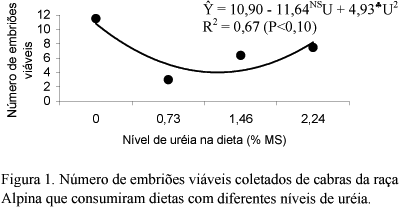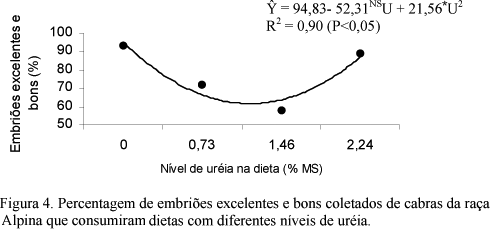Twenty-two Alpine goats were allocated at random into four treatments: 0.0% (T1 - control, n=5); 0.73% (T2, n=7); 1.46% (T3, n=4) or 2.24% (T4, n=6) of urea in the dry matter (DM) of the diet. Embryos collected from 7 to 8 days after mating of superovulated goat were evaluated by quality and development stage. Blood samples for urea and glucose analyses were collected at estrus and at embryos collection day. The DM (kg/day) and crude protein (kg/day) intake increased linearly in function of dietary urea level. Goat body weights were not affected by treatments out experimental weeks (P>0.05). Eighteen goats (81.8%) came in estrus after the synchronization. The estrus length and the interval from sponge removal to the beginning of estrus were not affected (P>0.05) by treatments. Fourteen goats (77.8%) were responsive to superovulation protocol. The levels of urea (treatments) did not affect structures and embryo numbers (P>0.05). Number (Y= 10.90 - 11.64NS U + 4.93<FONT FACE=Symbol>§</FONT>U²; R²= 0.67; P<0.10) and percentage (Y= 94.08 - 39.59NS U + 18.16<FONT FACE=Symbol>ª</FONT>U²; R²= 0.94; P<0.07) of viable embryos, and number (Y= 10.83- 12.18NS U + 5.02mU²; R²= 0.78; P<0.08) and the percentage (Y= 94.83- 52.31NS U + 21.56*U²; R²= 0.90; P<0.05) of excellent and good embryos were quadraticaly effected by urea dietary level. The treatments did not affect plasma urea and glucose levels (P>0.05). Diets for no nursing goats can be supplied by urea at 2.24% of DM.
goat; embryo; glucose; urea











